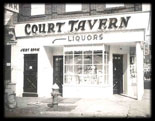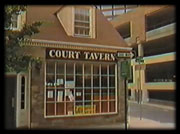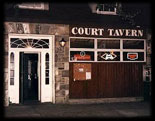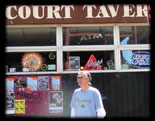
THE COURT TAVERN
I won't tell the Court's story, as it's been done here, and here, and here, and elsewhere. Paul Devlin's documentary Rockin' Brunswick focuses on the early 1980s New Brunswick bands, but there are two key moments regarding the city's nightlife. In the first, Jane Tublin, New Brunswick Arts Administrator, says "There are many clubs in New Brunswick that offer opportunities for young people to hear" — Tublin nervously shifts her eyes off camera before awkwardly continuing — "pop, and...rock and roll." It sounds like she'd never uttered the words before. In the second, Matt Pinfield enthuses, "New Brunswick is starting to grow. Growth as far as commercially, residentially, industrially, any of that type of thing, will help the venues as well."
That was hardly the sentiment a few years later, as the bulldozers made way for the encroaching redevelopment, transforming New Brunswick into its modern era. Dives like Patrix and the Roxy were about as welcome in the new New Brunswick as a strip joint. As the old buildings fell, a typical complaint was "they're scrubbing the city of its character." I sympathized with the unwashed sub-culture, but understandably, New Brunswick's governing members preferred the city not become the next Camden. No respectable going-out guide would direct out-of-towners to the Melody Bar or Court Tavern for entertainment, given the reasonable odds that a mugging awaited them. Nevertheless, for a short span of time, the clubs held on, indeed making New Brunswick a haven for local "pop and...rock and roll." As the other clubs vanished, the Court Tavern maintained its ground. Few thought it would survive the decade; in 1988 I predicted its paving over — also the fate of the original Court, which stood in the path of the Ferren Deck Mall.

My relationship with the Court was as a spectator, and not just of the bands, but of the place itself. What made the Court different — not just from locals like the Roxy or Patrix, but also NJ legends like City Gardens and Maxwell's — is that it was more moose lodge than public institution, with its suspicious elder guardians swigging Budweiser longnecks. One had the impression that no matter how good a band was, it was the audience that owned the place. Every night, the same cast of regulars seemed to be in attendance, and as the decade went on, the cast grew meaner. If I sound uncharitable, it's not my intention. The Court crowd was tough, and not often fair, but winning it over was a band's great reward. Other 80s venues had their identities, especially the Melody (so beloved that reunions take place semi-annually at, yes, the local Elks Lodge). But the Court, rather than reflecting the scene, steered the direction the scene would go: out of pop and into the splintered mess that was 1985-89.
If the pop sound of 1981-84 didn't disappear entirely from the Court in the latter half of the 80s, it was there you could sense the fading movement. My recollection is impressionistic and probably over-simplified, but it isn't off base. Fortunately for me, I was an enthusiast of the dark and angry (and funny and passionate) bands populating the Court in the late 80s. So I kept going, though the location was dodgy and the building seemed at any point ready to burst into flames or, more likely, to smolder into oblivion. The Court's sudden closing in January 2012 surprised me: after all it had been through, I never figured it to go out with a whimper. And what do you know? Against all expectations, it resurfaced months later under new ownership. Cleaner, brighter, but still identifiably the Court.



